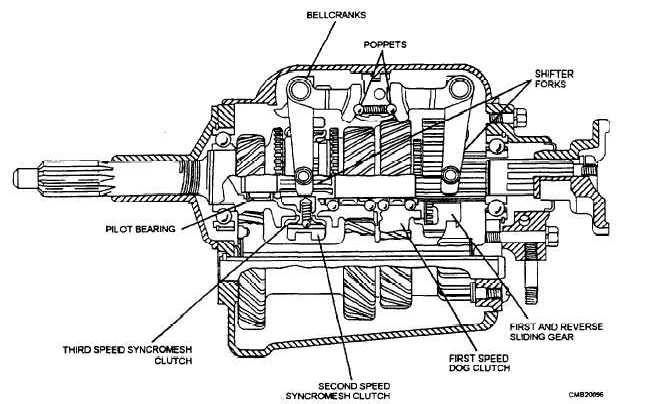the gears are free running but, when shifted, they are locked to their shafts by sliding collars.
The following is an example of the operation of a constant mesh transmission: When the shift lever is moved to THIRD, the THIRD and FOURTH shifter fork moves the sliding collar toward the THIRD speed gear. This engages the external teeth of the sliding collar with the internal teeth of the THIRD speed gear. Since the THIRD speed gear is meshed and rotating with the countershaft, the sliding collar must also rotate. The sliding collar is splined to the main shaft, and therefore, the main shaft rotates with the sliding collar. This principle is carried out when the shift lever moves from one speed to the next.
Constant mesh gears are seldom used for all speeds. Common practice is to use such gears for the higher gears, with sliding gears for FIRST and REVERSE, or for REVERSE only.
Synchromesh Transmission
The construction of the synchromesh transmission is the same as that of the constant mesh transmission with the exception that a synchronizer has been added (fig. 4-19). The addition of synchronizers allows the gears to be constant mesh when the cluster gears and the synchronizing clutch mechanisms lock the gears together.
The synchronizer accelerates or slows down the rotation of the shaft and gear, until both are rotating at the same speed and can be locked together without a gear clash. Since the vehicle is normally standing still when it is shifted into reverse gear, a synchronizer is not ordinarily used on the reverse gear.
POWER FLOW
Now that you understand the basic parts and construction of a manual transmission, we will cover the flow of power through a five-speed synchromesh transmission. In this example neither first gear nor reverse gear are synchronized.
Reverse Gear
In passing from neutral to reverse, the first-reverse main shaft gear is shifted rearward to mesh with the reverse idler gear (fig. 4-20, view A). The sole function of this gear is to make the main shaft rotate in the opposite direction to the input shaft; it does not affect gear ratio.

Figure 4-19. - Synchromesh transmission.
Continue Reading